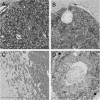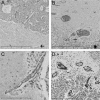Invasion patterns in brain metastases of solid cancers
- PMID: 24084410
- PMCID: PMC3829586
- DOI: 10.1093/neuonc/not112
Invasion patterns in brain metastases of solid cancers
Abstract
Background: Brain metastases are generally considered to be well demarcated from the surrounding brain parenchyma, although infiltrative growth patterns have been observed. We systemically investigated infiltration patterns and expression of adhesion molecules in a large and well-defined series of autopsy cases of brain metastases.
Methods: Ninety-seven autopsy specimens from 57 brain metastasis patients (primary tumor: 27 lung cancer, 6 breast cancer, 8 melanoma, 2 colorectal cancer, 1 kidney cancer, and 13 other) were evaluated for patterns of invasion into surrounding brain parenchyma. Expression of integrins αv; cytoplasmic β3, αvβ3, αvβ5, αvβ6, and αvβ8; and of E and N cadherin were evaluated using immunohistochemistry.
Results: Three main invasion patterns were seen: well-demarcated growth (29/57, 51%), vascular co-option (10/57, 18%), and diffuse infiltration (18/57, 32%). There was no statistically significant association of invasion pattern with primary tumor type, although vascular co-option was most common in melanoma brain metastases (4/10). Invasion patterns of different brain metastases of the same patient were highly concordant (P < .001, chi-square test). Distance of infiltration from the main tumor mass ranged from 12.5 µm to 450 µm (median 56.2 µm) and was not significantly different between the vascular co-option and the diffuse infiltration groups. Levels of αvβ6 were significantly higher in the well-demarcated group than in the vascular co-option and the diffuse infiltration groups (P = .033, Kruskal-Wallis test). Expression of αvβ5 in tumor cells was higher in brain metastasis lesions previously treated with stereotactic radiosurgery (P = .034, chi-square test).
Conclusions: Distinct invasion patterns of brain metastases into the brain parenchyma are not specific for primary tumor types, seem to be influenced by expression of αv integrin complexes, and may help to guide clinical decision-making.
Keywords: adhesion molecules; brain metastases; cadherin; integrin; invasion.
Figures



References
-
- Gavrilovic IT, Posner JB. Brain metastases: epidemiology and pathophysiology. J Neurooncol. 2005;75(1):5–14. - PubMed
-
- Wesseling P, von Deimling A, Aldape K. Metastatic Tumours of the CNS. 4th ed. Lyons, France: IARC Press; 2007.
Publication types
MeSH terms
Substances
LinkOut - more resources
Full Text Sources
Other Literature Sources
Medical
Research Materials

